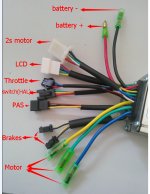BARE
1 mW
The Xiongda 2-speed intrigued me, having just built a vintage MTB 2 wheel drive conversion and finding the old fire look out ridge top roads were too much slow travel for the average hub motors. But now, having just completed the 2 wheel drive, 2 speed conversion, I find my chariot is out of sorts. Yes I have a 52 volt battery and a 48 volt controller on a 36 volt 300 watt motor. But I have the amps dialed down to 11 and I was just putting around on my first day's test when the bike starts to buck and bite like and old mule. Now, I point out that both KT LCD 4 displays are currently showing the brake symbol accompanied with no thrust. If, occasionally, the symbol is missing then one motor will spin, although weakly, while the other will spin a moment before 'nothing'. I've double checked all connections, and all look perfect. How is it that both motors are interacting while only being connected with the hand brake cutoffs and the HAL 2 speed switch. The controllers are joined with two XT60 connectors mating to one, to the battery. I'm not so electrically minded to dig deep. I imagine Eric Hicks of Luna Cycle knows my woes, but that was a past life time for him, yes?
Any thoughts?
Any thoughts?


